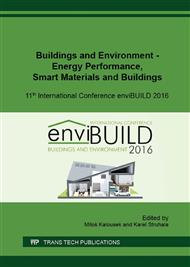[1]
Directive 2010/31/EU of the European Parliament and of the Council on the Energy Performance of Building (EPBD recast), Official Journal of the European Union 53 (2010), pp.13-35.
Google Scholar
[2]
A. Hermelink, S. Schimschar, T. Boermans, L. Pagliano, P. Zangheri, R. Armani, K. Voss, E. Musall Towards nearly zero-energy buildings. Definition of common principles under the EPBD, Ecofys, Köln, (2013).
Google Scholar
[3]
Report from the Commission to the European Parliament and the Council: Progress by Member States towards Nearly Zero-Energy Buildings, European Commission, Brussels, (2013).
Google Scholar
[4]
T. Boermans, A. Hermelink, S. Schimschar, J. Grözinger, M. Offermann K. Engelund Thomsen, J. Rose, S. O. Aggerholm, Principles for nearly zero-energy buildings. Paving the way for effective implementation of policy requirements. Building Performance Institute Europe, Brussels, (2011).
DOI: 10.1016/j.enpol.2011.03.029
Google Scholar
[5]
BPIE, Europe's buildings under the microscope. A country-by-country review of the energy performance of buildings, Buildings Performance Institute Europe, Brussels, (2011).
Google Scholar
[6]
BPIE, Implementing nearly zero-energy buildings (nZEB) in Bulgaria- Towards a definition and roadmap, Building Performance Institute Europe, Brussels, (2012).
Google Scholar
[7]
BPIE, Implementing nearly zero-energy buildings (nZEB) in Poland- Towards a definition and roadmap, Building Performance Institute Europe, Brussels, (2012).
Google Scholar
[8]
BPIE, Implementing nearly zero-energy buildings (nZEB) in Romania- Towards a definition and roadmap, Building Performance Institute Europe, Brussels, (2012).
Google Scholar
[9]
L. Carvalho, E. Wpopienka, C. Pointner, J. Lundgren, W. Haslinger, C. Schmidt, Performance of a pellet boiler fired with agricultural fuels. Appl. Energ. 104 (2013) pp.286-296.
DOI: 10.1016/j.apenergy.2012.10.058
Google Scholar
[10]
Verma, V.K., Bram, S., Delattin, F., Laha, P., Vandendael, I., Hubin, A. & De Ruyck, J. Agro-pellets for domestic heating boilers: Standard laboratory and real life performance. Appl. Energ. 90 (2012) p.17–23.
DOI: 10.1016/j.apenergy.2010.12.079
Google Scholar
[11]
Commission Delegated Regulation (EU) No 244/2012 of 16 January 2012 supplementing Directive 2010/31/EU of the European Parliament and of the Council on the energy performance of buildings by establishing a comparative methodology framework for calculating cost-optimal levels of minimum energy performance requirements for buildings and building elements, Official Journal of the European Union, 55 (2012).
Google Scholar
[12]
O. Fülöp, K. Severnyák, Cost Optimal Levels of Minimum Energy Performance Requirements of Buildings and Building Elements, Energiaklub Climate Policy Institute Applied Communications, Budapest, (2013).
Google Scholar
[13]
K. Severnyák, Cost optimality and / or sustainability in our building's life, Adv. Mat. Res. 899 (2014) pp.87-92.
Google Scholar
[14]
O. Fülöp, K. Severnyák, Cost Optimal Levels of Minimum Energy Performance Requirements of Buildings and Building Elements, Hungarian Building Services, 61 (2012) pp.8-14. (2012).
Google Scholar
[15]
A. Kerekes, Power factor and heat storage losses of biomass boilers, Hungarian Building Services, 63 (2014) pp.13-16; 64: (2015) pp.41-43.
Google Scholar


